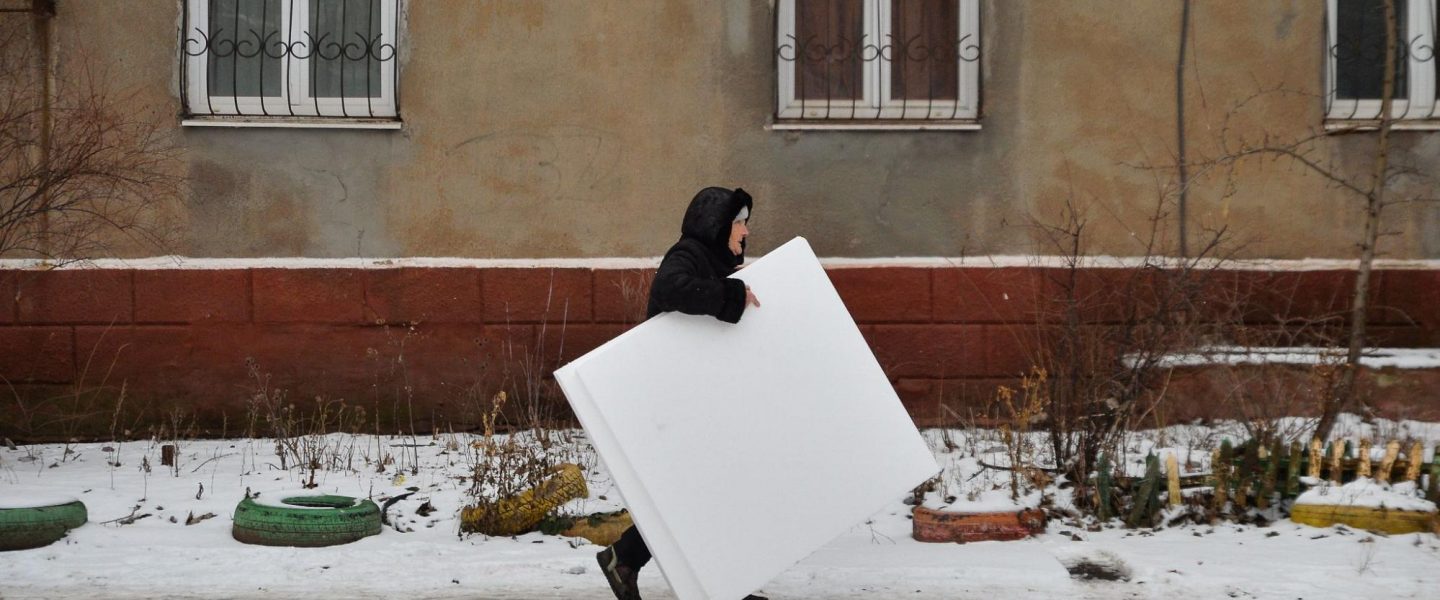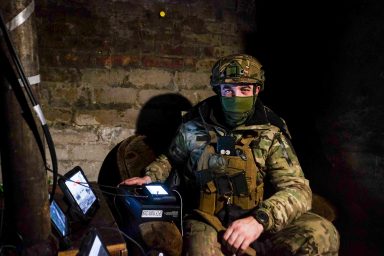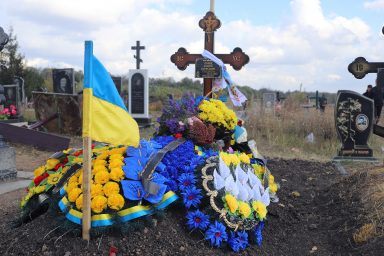Outgunned Ukrainian soldiers brace for a renewed Russian offensive in the Donbas.
|
Listen To This Story
|
NEAR SOLEDAR, Ukraine — “Attention… fire!” The detonation is deafening, lifting a cloud of dust and fresh snow off the frozen ground. The soldiers from Ukraine’s 10th Mountain Assault Brigade waste no time, hurrying to grab another shell and sliding it carefully in the barrel of their French-built MO-120-RT heavy mortar. One after another, rounds are sent flying towards the Russian line. The mortar position is located on the outskirts of a small village on the road to Soledar, a mere 3 kilometers (1.8 miles) from the front line, and the sounds of a fierce battle are echoing all around us: small arms fire, mortar rounds detonating in the distance, and the unmistakable thud-thud of a heavy machine gun. Artillery shells whizz over our heads, and come crashing in the distance seconds later.

A mortar crew of the 10th Mountain Assault Brigade preparing to fire at Russian positions towards Soledar, Ukraine. Photo credit: Madeleine Kelly / WhoWhatWhy
The men manning the mortar, however, seem unfazed. After firing their fifth shell, they cover the weapon with a camouflage net and light up a cigarette. “We’ve been here for weeks,” says one of them, intimating that the position is — relatively — safe from Russian counter-battery fire. This, however, could soon change, as Ukrainian intelligence has been warning for weeks that a renewed Russian offensive in the region could begin in earnest.
As the Russian army has experienced one setback after another, Russian President Vladimir Putin is desperate to claim a victory at all costs. And according to most analysts, his sights are set on eastern Ukraine. During his Sunday address, Ukrainian President Volodymyr Zelenskyy warned that Russia might “do something symbolic in February” to make up for their humiliating retreats from the Kharkiv and Kherson regions. “We see this increased pressure in various directions of the front,” Zelenskyy said. “It is very difficult in [the] Donetsk region.”
This fact has not escaped “Aske,” the grizzled veteran in charge of the mortar unit: “The situation here is difficult, as it is one of the hottest spot[s] on the frontline,” Aske says. “And according to most assessments, the Russians are preparing for a breakthrough in this area.”
According to Kyrylo Budanov, the head of Ukraine’s military intelligence, about 326,000 Russian troops are currently fighting in Ukraine — more than the initial invading force — and another 150,000 have already been mobilized. In recent weeks, the frequency of the shelling has also been increasing. Last Wednesday, military analyst Konrad Muzyka estimated that the number of reported Russian artillery barrages had risen from an average of about 60 per day a month ago, to more than 90 last week.
Civilians are bearing the brunt of the intensifying shelling, as cities once considered relatively safe are being targeted by Russian missile strikes. On Wednesday, an Iskander ballistic missile struck a residential building in the center of Kramatorsk, killing four and wounding at least 20. Less than 12 hours later, more rockets landed on the city, blowing massive holes in the middle of an avenue and in the courtyard of a residential building.

A wounded Ukrainian serviceman is brought to the hospital in Kramatorsk. Photo credit: Madeleine Kelly / WhoWhatWhy
According to Pavlo Kyrylenko, the head of the Donetsk region’s military administration, at least five people were wounded in Thursday’s attack. “Why are they bombing the city center? There is no military here,” sighs Viktor, a resident of Kramatorsk, as he stares at the crater left by the rocket. On the other side of the avenue, policemen and members of the SBU — Ukraine’s security service — were combing the scene for remnants of the missile, as smoke billowed from a destroyed garage.

Firefighters searching for survivors following last Thursday’s missile strikes in Kramatorsk. Photo credit: Madeleine Kelly / WhoWhatWhy
“As the frontline gets closer, life becomes more difficult for civilians,” says Vadym Lyakh, the head of the military administration of Sloviansk, a city located around 10 kilometers (~6 miles) from Kramatorsk. While the fighting around Bakhmut and Soledar has been raging for months, Lyakh believes that the Russian troops freed by the consecutive retreats from the regions of Kharkiv and Kherson could be brought to bear on the Donbas front. The Ukrainian soldiers facing them are motivated, but also outgunned: The most common complaint heard at the front is a lack of shells. With Ukraine firing more than 5,000 artillery rounds each day, and with much of the highly publicized Western weaponry yet to arrive at the frontline, ammunition is running low. “We used to fire up to a hundred shells a day,” says “Granit,” a soldier from the 10th Mountain Assault Brigade who is manning a Soviet-built 122 mm artillery piece in the direction of Soledar. “Now, we can fire only 10 or 15 at most.”

The funeral of Denys Sosnenko, a 21-year-old aid worker from Sloviansk, killed after driving over an anti-tank mine. Photo credit: Madeleine Kelly / WhoWhatWhy
While Ukraine inherited huge stocks of 152 mm artillery following the collapse of the Soviet Union, eight years of war in the Donbas and months of high-intensity fighting have left the country struggling to match Russian firepower. Kyiv’s partners are doing their best to cope with the demand, with the Pentagon announcing in late January that it would increase sixfold the production of 155 mm shells. Meanwhile, France and Australia have agreed to begin joint production of artillery rounds for the Ukrainian Armed Forces, with the first supplies expected to be delivered in late April. Those much-needed shells might arrive too late however, as Oleksiy Reznikov, Ukraine’s defense minister, warned on Sunday that a renewed Russian offensive might take place around the 24th of February — one year to the day since the beginning of the invasion.
“Of course, we expect possible offensives from the Russians,” Reznikov said during a press conference held in Kyiv. “They like symbolism.” Aske and his men, however, are determined to hold the line: “We are ready, we’re waiting for them, and we’ll meet them with fire.”




